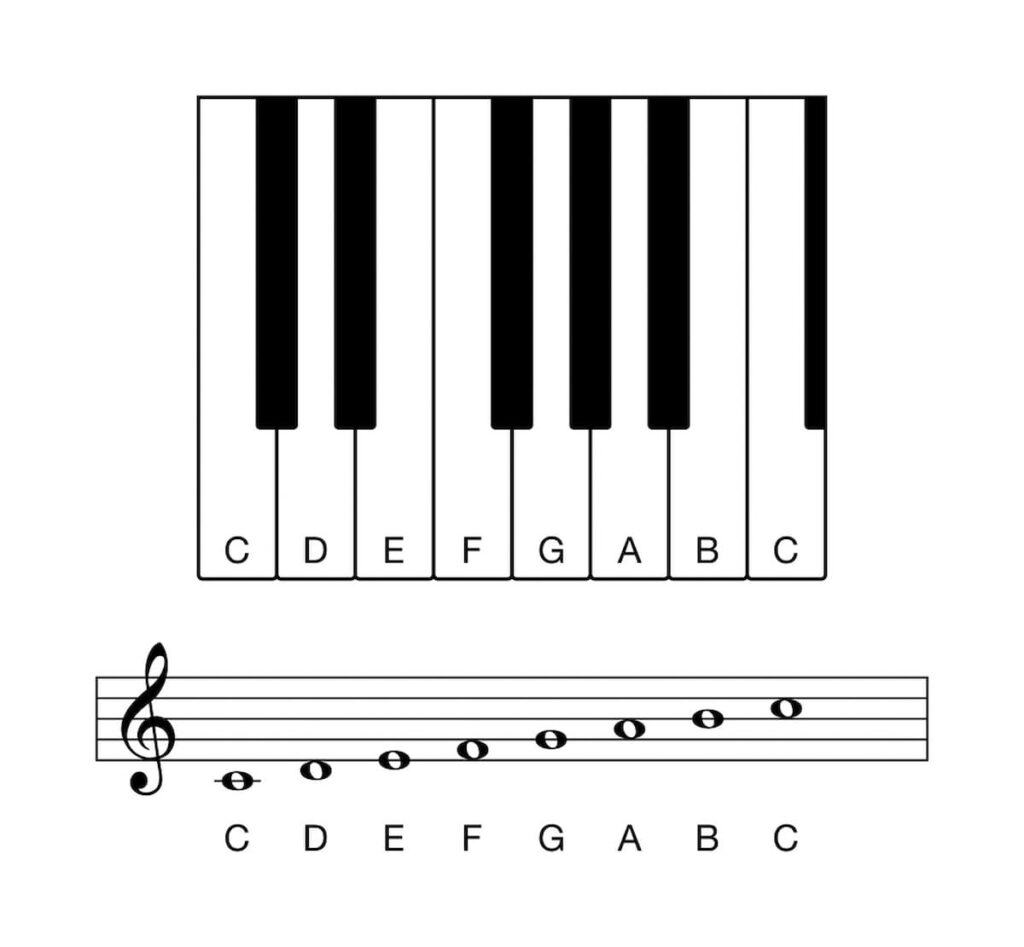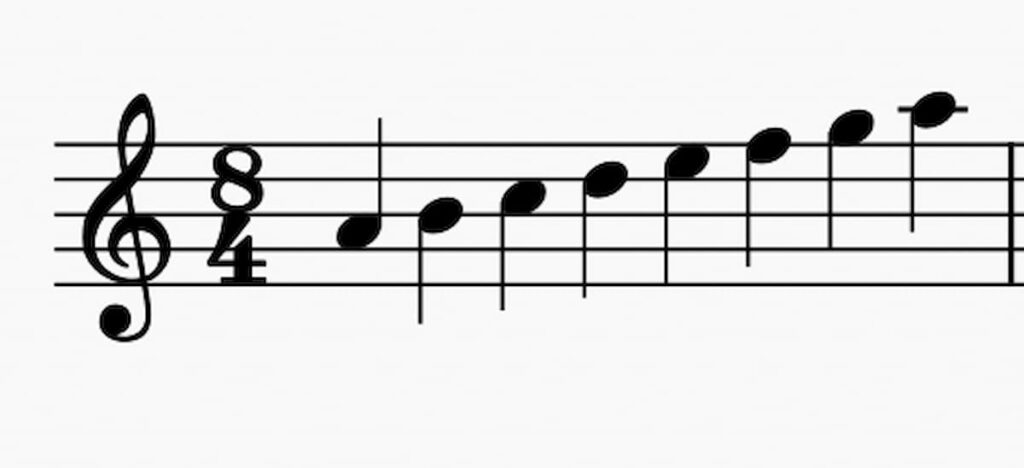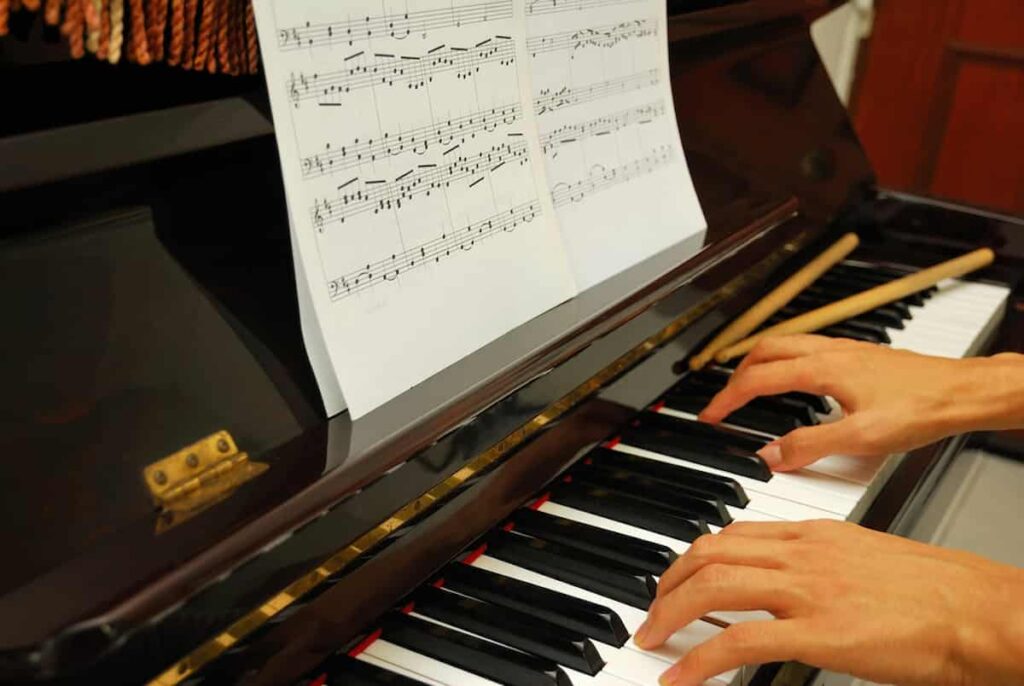As an Amazon Associate I earn from qualifying purchases.
Whether you’re a new piano student or just testing things out, it’s important to build good habits early at the instrument. One way we can do this is by practicing scales. There are a ton of scales for the piano; at first, it may not be obvious which ones you should be playing.
To help you get the most f your playing, I’ve compiled a complete list of the best piano scales for beginners. This includes scales sorted by specific keys and various scale types (not just the one-octave scales).
Let’s hop into it.
One Octave Piano Scales For Beginners
One-octave scales are a great way to get started with learning the piano. They are great for warmups to work on your technique, fingering, and tone production.
You can choose several modes, but I think a mix of major and select minor scales is the way to go. Let’s start with C major.
C Major Scale
Want to Learn Piano?Click Here

When you think of piano scales, the C major scale is the first that comes to mind. It’s the easiest one to read in sheet music and starts on the most popular piano key, middle C.
The production of it is quite simple. C, D, E, F, G, A, B, C. The fingering for the C major scale is 123,12345.
I also love this scale because most beginner piano pieces start in this key, especially if you’re studying with a method book.
Practicing it daily will make you more comfortable with the hand position needed to play the piece. In addition, if your piece includes chords, you’ll be better equipped to take them on when they arrive and have an idea of some fingering that you can try.
A Natural Minor

The A natural minor scale is a great scale to follow up with. It’s in the relative minor key of C major. This means it’s going to use the same key signature. This means no white keys!
The tone of the scale is minor, so it’ll have sadness to it. When it comes to minor scales, it’s an easy, less complex one to start with to train your ear for that type of sound. As with all natural minor scales, it features a minor third scale degree, a minor sixth, and also a minor seventh.
The fingering is also the same.
G Major Scale

G major is the best choice when you’re finally ready to add black keys into your one-octave scales. I appreciate this piano scale because the sharp only occurs on the seventh note.
So, in this case, it’ll be F sharp.
The fingering will be the same, and the sharp will occur on finger four if you’re using your right hand to play this scale.
Because major scales end with a half step, it’s easy to form that leading tone on this scale. I think it’s also beneficial not to have multiple black keys mixed into different parts of the scale, making it less confusing to approach at first.
F Major Scale
The F major scale also features just one black key; however, its role differs. Rather than it being a sharp, it’ll be a flat key this time.
The F major scale features a B flat. It’ll be played by finger 4.
This scale is a bit more complex because the fingering changes compared to the others; this is the case for the right hand.
The fingering will be 1,2,3,4,1,2,3,4. While different than the standard fingering, it’s easy to remember. However, if you’ve practiced the other scales in this list a lot, you’ll have to get used to not performing the crossunder of the thumb until after the fourth finger.
The left-hand fingering, however, is what you would expect; 5,4,3,2,1,3,2,1. The first time you play finger two, the flat will occur in the middle of the scale.
If you start performing your scales hands together at some point, the pattern difference may bug you. That’s understandable. However, you’ll find that both thumbs line up on the scale, both ascending and descending. The diagram below illustrates that:

B Major Scale

While the B major scale features multiple black keys, I find the approach to this scale easy if you think of it this way.
One of the first things a new piano student should learn is the two black keys and three black keys. Fingers 2 and 3 will be on the pattern of two, and fingers 2, 3, and 4 will be on the pattern of three. From there, you fill in the white keys in the scale’s beginning, middle, and end.
So it’ll be B, two black keys, E, three black keys, and then the final B to end the scale. The diagram below illustrates the B major scale how I view it:

By approaching it this way, you can get a visual grip on the scale at the piano and think less about what’s sharp and what’s flat.
Pentatonic Scales (Pentascales)
Pentatonic scales are a great introduction to scales on the piano. There are a few qualities about them that I think a beginner pianist would appreciate, and these include:
- Fewer notes compared to one-octave scales (just 5)
- Most are white keys
- Simple fingering (no crossovers or crossunders)
- Easy to recognize and perform in music
Here’s an octave of a simple pentatonic scale in C major:

Much like one-octave scales, the first two you should start with are C major and A minor. They feature all-white keys. After that, you can also do G major, and D minor, as those also don’t have black keys.
Once you’re ready to add in black keys, you have a few options. You can play the minor versions of some scales or approach other major scales.
Below is a list of Pentascales that feature just one black key:
- C minor
- D major
- A major
- G minor
Once you’re comfortable there, I suggest going into those with one to two black keys. This would include B major and F minor. Beyond that, you can start playing pentascales that begin on flats and sharps, but most beginner piano music won’t require those kinds of scales.
When choosing which scale types you practice, try to match it to whatever music you are learning at the time, so it’s beneficial to your practice sessions.
Practice Strategies For All Scale Types
To be proficient at musical scales, you must approach them correctly. Otherwise, you’ll be wasting time touching keys without any real goal. Scales are designed to develop your technique and also your musical ear.
Piano scales are essential for quicker note reading. The more you practice these patterns, the quicker you can execute them in full pieces of music.
Below are some strategies to practice your scales and get the most out of them when playing the piano.
Use The Circle Of Fifths
Once you have a firm grasp of piano scales, it’s helpful to practice them in the order of the circle of fifths. Take a look at the chart below:

As you follow the circle, you’ll notice it starts with the C major scale (the easiest one) and then adds a sharp with each clockwise move. That means your next scale would be G major (has one sharp), followed by two sharps (D major), and so forth.
This circle can also be used to practice scales that feature flats.
It’s easy to understand the progression of scales and memorize them better. It’s better than just going in alphabetical order because if you did that, the way you introduce sharps and flats would feel random and not chronological.
Using the circle of fifths to practice scales is smart, covering major and minor scale modes.
Practice the Scales With Your Index Finger First
Switching between fingers is an important skill for all pianists. Sometimes, however, it’s not the best way to approach a scale when you’re a beginner.

Instead, you can “poke” out each note of the scale you’re practicing. I use my index finger. This helps with two things:
- allows you to play the scale with ease
- enables you to hear all of the notes without pauses
If crossunders and crossovers are something other than what you’ve already worked on, that can cause plenty of hiccups early on in the scale. So, playing with just one finger is really helpful. Give it a try!
Break The Scale Into Halves
Breaking the piano scale in half is another great practice strategy. The first half can be just five notes (the pentatonic scale), and then the last half is just three keys.
For most right-hand musical scales, the pentascale happens on the back half. For the left hand, the pentascale would occur first.
It’s simple and effective.
Use A Metronome
Speed is the number one issue with playing scales. Play it too fast, and you’ll lose control. Play it too slow, and you’ll never grab the sensation of crossing fingers and the momentum necessary to do it well in a passage of music.
Metronomes help with this. It promotes the evenness of the notes and also helps with pacing.

I’d set a maximum slow tempo of 60 BPM with a metronome (just Google “Metronome”). Then, each note of the scale can be performed at two eighth notes per beat.
Gradually increase the tempo until you can get it to your desired speed.
I know a lot of musicians are picky about metronomes, but it’s quite helpful if you’re new to piano playing. Avoid leaving it on during the duration of the scale once you feel comfortable with the tempo. Just turn it on for a few clicks so you can get it in your ear, and then you can turn it off and proceed to practice.
Expanding Your Scale Knowledge
In addition to one octave and pentatonic scales, beginners might find other scale types helpful to their practice. These are perfect when you’re ready to incorporate intermediate to advanced exercises to aid your playing.
Contrary motion scales
I’ve mentioned contrary motion scales in other posts here, but it’s an awesome scale. It’s something a beginner can easily do, and it’s essential for when you’re ready to put your hands together.
This scale can start with the thumbs on the same key, so let’s say Middle C for this example. They will then play contrary directions from one another. So, both hands can play the scale going away from one another and then in towards one another.
It’s a simple way to start because the fingering will be the same for each hand. From there, you can start adding parallel scales where they play in the same direction because the fingering is inverted on parallel scales; it’s usually a bit more complex.

Harmonic and Melodic Minor Scales
Harmonic and melodic minors are the next level up from natural minor scales.
The harmonic minor scale lowers the third and sixth scale degree but raises the seventh, so you have a half step there. An easy one to start with is A harmonic minor because it’ll only feature one black key because of this.
Melodic minors do a bit more, lowering the third scale degree but raising the sixth and seventh. This causes your scale to sound close to a major scale. B major melodic minor is a nice beginner piano scale to start with.
The Takeaway
I hope you found this guide on piano scales for beginners helpful. In all my playing and teaching experience, starting with the majors is the way to go. Try out some practice strategies, and this approach to the scales will make the experience that much better!
Hello & thanks for stopping by! I’m a professional concert pianist and piano instructor. In the United States, I’ve given successful performances in several places including New York, Florida, Connecticut, & New Jersey, I have also performed internationally in Italy and made my Carnegie Hall debut in 2014. I enjoy blogging about the piano, the art of performance, general music, current events and the latest in music production.
